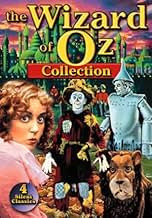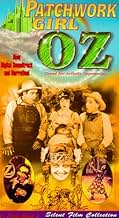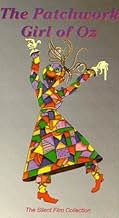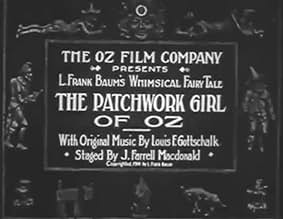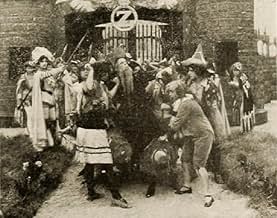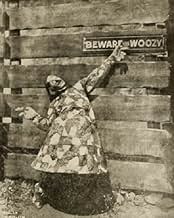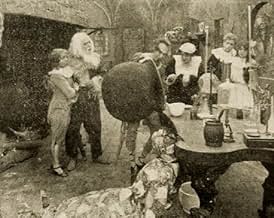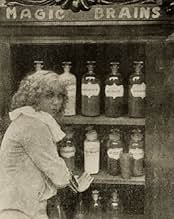Aggiungi una trama nella tua linguaOjo and Unc Nunkie are out of food, so they decide to journey to the Emerald City where they will never starve.Ojo and Unc Nunkie are out of food, so they decide to journey to the Emerald City where they will never starve.Ojo and Unc Nunkie are out of food, so they decide to journey to the Emerald City where they will never starve.
Leontine Dranet
- Margolotte, his wife, who makes the Patchwork Girl
- (as Haras Dranet)
Richard Rosson
- Danx, a Noble Munchkin
- (as Dick Rosson)
Bert Glennon
- The Scarecrow
- (as Herbert Glennon)
Hal Roach
- The Cowardly Lion
- (as Al Roach)
- …
Dave Anderson
- The Hungry Tiger
- (as Andy Anderson)
Pierre Couderc
- Scraps, the Patchwork Girl
- (as The Marvelous Couderc)
Recensioni in evidenza
L. Frank Baum himself produced and wrote this adaptation of his own Oz book, a full quarter century before Judy Garland strolled the yellow brick road. What survives is an intriguing artifact from cinema's infancy, antiquated in style and naive in sentiment, but compensating with plenty of charm for what it lacks in sophistication. The influence of theater can still be seen in the histrionic acting and static camera set-ups, but the affection Baum lavished on his creations (munchkins, magicians, 'hoppers', the 'woozy') is clearly evident, even today. His fertile imagination, reinforced by some clever (if primitive) camera tricks, makes this an enchanting fantasy with more than merely academic interest for students of early film history.
The most famous movie adaptation of a novel by L. Frank Baum entails Toto, a tornado, ruby slippers and a yellow brick road. Well, it turns out that Victor Fleming's 1939 adaptation was not the first. An earlier screen version of "The Wizard of Oz" was a 1925 loose adaptation of the story, notable for casting Oliver Hardy as the Tin Woodsman.
And then there were the adaptations in which Baum himself participated. He founded the Oz Film Manufacturing Company and made some movie versions of his novels. These aren't the most sophisticated adaptations but are worth seeing as a look into early cinema. "The Patchwork Girl of Oz" features things like people getting turned into statues (and one of them getting shrunken down so that a woman can carry him). Yeah, Baum came up with some wacky stuff.
One interesting thing about this movie is that the lion is played by none other than Hal Roach, best known as the producer of Laurel & Hardy's movies. It appears that only Stan Laurel didn't get to go to Oz on the silver screen. Of course, I can't picture him in Oz without imagining that he would have turned everything upside down. In other words, it would have been another fine mess that he'd gotten himself into!
Anyway, this movie is worth seeing. I wonder what Baum would have thought of the most famous adaptation of his work, had he lived to see it.
And then there were the adaptations in which Baum himself participated. He founded the Oz Film Manufacturing Company and made some movie versions of his novels. These aren't the most sophisticated adaptations but are worth seeing as a look into early cinema. "The Patchwork Girl of Oz" features things like people getting turned into statues (and one of them getting shrunken down so that a woman can carry him). Yeah, Baum came up with some wacky stuff.
One interesting thing about this movie is that the lion is played by none other than Hal Roach, best known as the producer of Laurel & Hardy's movies. It appears that only Stan Laurel didn't get to go to Oz on the silver screen. Of course, I can't picture him in Oz without imagining that he would have turned everything upside down. In other words, it would have been another fine mess that he'd gotten himself into!
Anyway, this movie is worth seeing. I wonder what Baum would have thought of the most famous adaptation of his work, had he lived to see it.
A young munchkin named Ojo (played by Violet MacMillan) and her Unc Nunkie decide to set out in search of a better life in the Emerald City of Oz. Along the way, they meet and befriend a magician and his family. The magician has long been at work on perfecting a magic powder of life, his wife having created a patchwork servant girl whom they hope to bring to life. Things go awry when the newly awakened patchwork girl accidentally spills a petrification fluid upon the Magician's wife and his future son in-law as well as Ojo's Unc Nunkie. Now our heroes (the Patchwork Girl, Ojo, the Magician and his daughter) must combine forces in search of the different, rare and hard to obtain ingredients necessary for a spell to undo the petrification process. Many unusual adventures, magical as only the world of Oz can be, await.
This delightful flight of fancy provides viewers with a fun escape from reality. The actors and actresses breathe such a wonderfully vibrant energy into their lively performances that they prove quite a joy to watch. Basically this starts off as a series of individual stories focused on a wide number of colorful characters. By the film's end however, all these different characters and their individual stories seem to merge together into one near epic tale. Of the three 1914 Oz film produced in part by L. Frank Baum himself, this one is clearly the best and most complete adventure story.
This delightful flight of fancy provides viewers with a fun escape from reality. The actors and actresses breathe such a wonderfully vibrant energy into their lively performances that they prove quite a joy to watch. Basically this starts off as a series of individual stories focused on a wide number of colorful characters. By the film's end however, all these different characters and their individual stories seem to merge together into one near epic tale. Of the three 1914 Oz film produced in part by L. Frank Baum himself, this one is clearly the best and most complete adventure story.
As a child, The Patchwork Girl of Oz was my favorite Oz book. This silent film version is a charming look at how Oz was envisioned by it's creator--L. Frank Baum produced the film. The story however does stray from the book and some of the scenes are a bit disjointed. Motion pictures were in their infancy in 1914--most films were stagebound dramas, so to see a fantasy film from this period is unique.
The Patchwork Girl or "Scraps" is played by French acrobat Pierre Couderc. The part where Scraps catches the eye of the Scarecrow is very amusing. Also, the Yoop character is a forerunner to the Winged Monkeys who terrorized Judy Garland 25 years later.
In the video version I saw, the pivotal scene where Scraps is brought to life and tips over the Liquid of Petrification, is missing or destroyed--but the rest of the film is intact however.
The Patchwork Girl or "Scraps" is played by French acrobat Pierre Couderc. The part where Scraps catches the eye of the Scarecrow is very amusing. Also, the Yoop character is a forerunner to the Winged Monkeys who terrorized Judy Garland 25 years later.
In the video version I saw, the pivotal scene where Scraps is brought to life and tips over the Liquid of Petrification, is missing or destroyed--but the rest of the film is intact however.
A feast of quaint but super-hectic activity, presented before a solidly stationary camera (except for the effective concluding shot), this is a dated and none too interesting attempt by author L. Frank Baum himself to transfer his Oz from the printed page to the cinema. He is let down by the totally unimaginative direction (from well-known character actor J. Farrell MacDonald), the almost entirely stationary camera-work (though there are a couple of clever touches here and there) with its long, boring takes, and the inappropriately over-the-top enthusiasm of almost all the players.
As a curiosity, the movie would make a tolerable two-reeler, but 65 minutes of repetitious jumping, sliding, running, kicking, dancing, climbing, gallivanting, funning and frolicking, is, despite the picturebook tints and novel costumes of its picturebook illustrations brought to life, just far too much of a mediocre thing.
Now, if the highly imaginative original drawings by W.W. Denslow that accompanied Baum's first and most famous venture into the land of Oz, The Wonderful Wizard of Oz (1900), had been brought to life rather than the conventional Victoriana here displayed, the film would doubtless have captured an audience's interest far more than this ultimately wearisome parade. Unfortunately, there was no chance of that happy eventuality. Baum and Denslow had a falling out in 1901 when both men claimed that the instant success of Oz was primarily due to their own input. Therefore it's no surprise that producer Baum made it his business to ensure the movie's visuals were as far removed from Denslow's creations as possible.
As a curiosity, the movie would make a tolerable two-reeler, but 65 minutes of repetitious jumping, sliding, running, kicking, dancing, climbing, gallivanting, funning and frolicking, is, despite the picturebook tints and novel costumes of its picturebook illustrations brought to life, just far too much of a mediocre thing.
Now, if the highly imaginative original drawings by W.W. Denslow that accompanied Baum's first and most famous venture into the land of Oz, The Wonderful Wizard of Oz (1900), had been brought to life rather than the conventional Victoriana here displayed, the film would doubtless have captured an audience's interest far more than this ultimately wearisome parade. Unfortunately, there was no chance of that happy eventuality. Baum and Denslow had a falling out in 1901 when both men claimed that the instant success of Oz was primarily due to their own input. Therefore it's no surprise that producer Baum made it his business to ensure the movie's visuals were as far removed from Denslow's creations as possible.
Lo sapevi?
- QuizHarold Lloyd and Hal Roach, who both have minor roles in this film, met on this set in San Diego. Roach was impressed by Lloyd's energy and sought him out when he formed his production company The Rolin Film Company in July 1914 after receiving a small inheritance. Although their association was stormy, their association was ultimately one of the most successful in silent film history.
- BlooperThe character of Ojo is stated several times to be a boy, but is referred to as a girl in one of the dialogue caption cards.
- ConnessioniFeatured in American Masters: Harold Lloyd: The Third Genius (1989)
I più visti
Accedi per valutare e creare un elenco di titoli salvati per ottenere consigli personalizzati
- How long is The Patchwork Girl of Oz?Powered by Alexa
Dettagli
- Tempo di esecuzione1 ora 21 minuti
- Colore
- Mix di suoni
- Proporzioni
- 1.33 : 1
Contribuisci a questa pagina
Suggerisci una modifica o aggiungi i contenuti mancanti

Divario superiore
By what name was The Patchwork Girl of Oz (1914) officially released in Canada in English?
Rispondi
